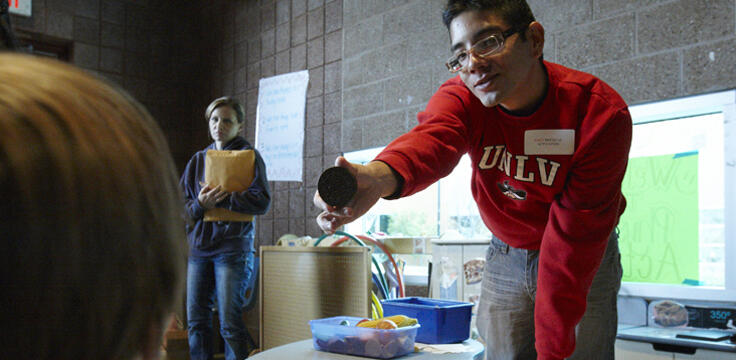Juan Ramirez has stumped a few preschoolers. "Are French fries a growing food?" asked Ramirez, a UNLV student who's testing if preschoolers' can tell the difference between nutritious foods and the unhealthy munchies adults and kids can't seem to avoid. While some kids can't name raspberries and limes, Oreos and Doritos are no problem.
The fries question puzzles the kids. Only 4-year-old Finn Hudson chimes in.
"Some are," the preschooler says, probably thinking of the baked sweet potato fries his mom makes. Hudson, used to seeing fruits and vegetables in his lunch and dinner, knows the drill by now. "These are chocolate chip cookies. They are not healthy," he says when Ramirez poses another question.
Ramirez has the kids jump up and down whenever he shows foods that are good for them.
Ramirez was one of 60 UNLV students in professor Monica Lounsbery's kinesiology class. As part of a class project, he stressed the connection between healthy eating, physical activity, and stronger bodies to 50 UNLV preschoolers in early December.
Lounsbery challenged her students to find out what prevented people from physical activity and create ways to promote exercise. The earlier physical activities are introduced, she said, the less likely it is that kids will lapse into sedentary behavior, which typically develops in childhood and carries on throughout adulthood.
Experts recommend an hour of play each day for kids. Yet, increasingly around the nation, physical education (P.E) has disappeared from schools, and kids, at best, have 20 minutes for recess and lunch combined.
"One of the only access points to physical education, irrespective of income, is school. Everyone has P.E. at some point. We're just not using that asset very well," said Lounsbery, director of UNLV's Physical Activity Policy Research program.
"Physical inactivity is the public health challenge of our lifetime," Lounsbery said, adding more than 80 percent of children nationwide do not meet the physical activity guidelines of an hour of exercise each day.
Let's Move - Now
Medical experts link chronic disease and high obesity rates to inactive lifestyles. The Centers for Disease Control and Prevention (CDC) estimates obesity among children aged 6 to 11 in the U.S. rose from 7 percent in 1980 to nearly 20 percent in 2008.
While national campaigns devoted to healthy eating like the CDC's Five-A-Day program has been successful, there's little done, especially at local levels, to encourage daily exercise, Lounsbery said.
Her latest research on how Southern Nevada residents use parks finds residents have little time to make physical fitness part of their daily routine, use parks for picnics more than exercise, and cite safety and lighting concerns as barriers to working out.
"Las Vegas has a lot of built environment challenges for people to be physically active," Lounsbery said.
Some parents surveyed before the preschool event said they did not know of parks and community centers near their homes where could take their kids to play.
Lounsbery urges policymakers to promote physical activity by creating more accessible and affordable neighborhood facilities that allow families to work out together.
Students and UNLV researchers are also hoping parents will fill the gap schools cannot meet. If kids are masters of convincing their parents to buy toys and happy meals, could they influence a parent to take them outside to play more often? After the preschool event, parents reported that their kids asked them to play outside more often than before the event.
Natalie Hudson, Finn's mom, said she devotes time to ensure her kids are active. On weekends, she takes a yoga class while Finn and 6-year-old Aiden, play in her gym's kids center. She said it's important for the kids to see her exercising and she motivates them to stay active so they can join her in the gym when they're older. At home, they family plays outside and tries indoor activities like gymnastics.
"I eat healthy and I think the best way is to model for them what's healthy and what's not," said Natalie Hudson, a UNLV employee who will soon teach at the university's Singapore campus.
The iPad versus the Playground
Gadgets are becoming babysitters more than learning tools, a concerning trend for Lounsbery's students.
"Physical activity has been engineered out of daily life," said Dina Cohen, a kinesiology major, who talked to kids about how to keep a healthy heart. "It's getting too easy not to be physically active."
UNLV student Alex Wilson, echoed Cohen's concerns. Wilson is worried that kids becoming glued to video games and cell phones before their preteens will affect their willingness to exercise.
"Even Barbie doesn't have to climb the stairs," said Wilson referring to a Barbie dreamhouse that's equipped with elevators.



